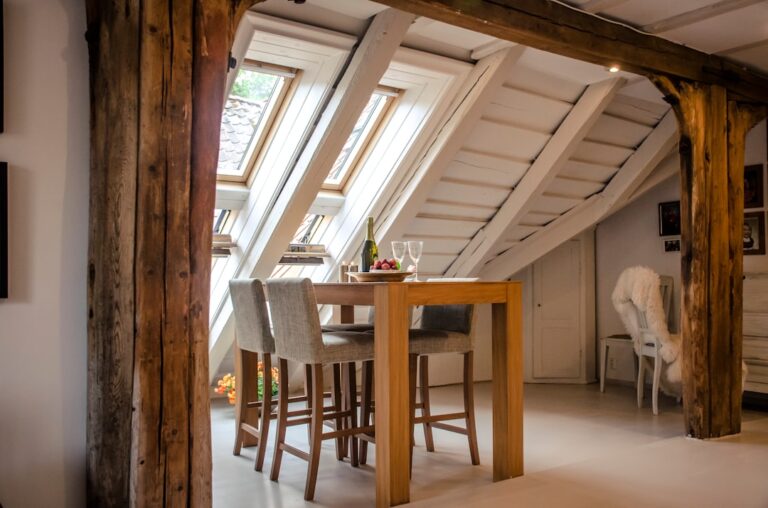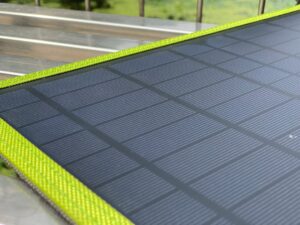Sagging rooflines and beams can be a homeowner’s worst nightmare, often signaling underlying structural issues that require immediate attention. The causes of this phenomenon can be varied and complex, ranging from natural wear and tear to more severe environmental factors. One of the primary culprits is the accumulation of excess weight on the roof.
This can occur due to heavy snowfall, ice buildup, or even the installation of heavy roofing materials that exceed the original design specifications. Over time, this added weight can lead to a gradual sagging of the roofline, compromising the integrity of the entire structure. Another significant factor contributing to sagging is moisture damage.
Water intrusion from leaks or poor drainage can weaken wooden beams and trusses, leading to a loss of structural integrity. In many cases, homeowners may not realize that their roofs are leaking until visible signs of sagging appear. Additionally, improper construction techniques or the use of substandard materials during the initial building process can exacerbate these issues.
As a result, understanding the root causes of sagging rooflines and beams is crucial for homeowners who wish to maintain the safety and longevity of their homes.
Key Takeaways
- Sagging rooflines and beams can be caused by factors such as age, weather, poor construction, and excessive weight.
- Structural damage should be assessed by a professional to determine the extent of the problem and the best course of action.
- Hiring a professional structural engineer is crucial for accurately diagnosing and addressing the structural issues.
- Repair options for sagging rooflines and beams may include reinforcement, temporary supports, and repairing or replacing damaged materials.
- Reinforcing rooflines and beams can help prevent future sagging issues and ensure the structural integrity of the building.
Assessing the Structural Damage
Visual Inspection: The First Line of Defense
Once sagging has been identified, a thorough assessment of the damage is essential. This process begins with a visual inspection of the roof and beams, looking for obvious signs of distress such as cracks, warping, or separation at joints. Homeowners should also check for any visible water stains or mold growth, which may indicate underlying moisture problems.
Delving Deeper into the Structure
However, a visual inspection alone may not provide a complete picture of the extent of the damage. It is often necessary to delve deeper into the structure to assess hidden issues that may not be immediately apparent. In addition to visual inspections, homeowners may benefit from employing specialized tools and techniques to evaluate the structural integrity of their roofs and beams.
Comprehensive Evaluation and Expertise
For instance, using a level can help determine how much sagging has occurred, while moisture meters can identify areas with excessive dampness. Engaging a professional for a more comprehensive evaluation can also be invaluable. Structural engineers possess the expertise to identify potential weaknesses and recommend appropriate solutions based on their findings. By thoroughly assessing the damage, homeowners can make informed decisions about the necessary repairs and reinforcements needed to restore their roofs to a safe and stable condition.
Hiring a Professional Structural Engineer

When faced with sagging rooflines and beams, hiring a professional structural engineer is often a prudent step for homeowners. These experts bring a wealth of knowledge and experience to the table, enabling them to accurately diagnose structural issues and recommend effective solutions. A structural engineer will conduct a detailed assessment of the property, taking into account various factors such as building codes, load-bearing capacities, and material conditions.
Their expertise ensures that any repairs or reinforcements are not only effective but also compliant with local regulations. Moreover, engaging a structural engineer can provide peace of mind for homeowners who may feel overwhelmed by the complexities of structural repairs. These professionals can offer guidance throughout the entire process, from initial assessments to final repairs.
They can also collaborate with contractors to ensure that all work is executed according to their specifications. By investing in professional assistance, homeowners can avoid costly mistakes and ensure that their homes remain safe and structurally sound for years to come.
Exploring Repair Options
| Repair Option | Pros | Cons |
|---|---|---|
| DIY Repair | Cost-effective, Learning experience | Time-consuming, Risk of mistakes |
| Professional Repair | Expertise, Time-saving | Higher cost, Dependence on others |
| Replacement | Long-term solution, Warranty | Expensive, Disposal of old item |
Once the extent of the damage has been assessed and a professional opinion has been obtained, homeowners can begin exploring repair options for their sagging rooflines and beams. There are several approaches to consider, depending on the severity of the sagging and the underlying causes. For minor sagging issues, simple repairs such as reinforcing existing beams or adding additional support may suffice.
This could involve installing new braces or struts that help redistribute weight more evenly across the structure. In more severe cases, however, homeowners may need to consider more extensive repairs or even complete replacements of damaged materials. This could involve removing and replacing sagging beams or trusses with new ones that meet current building standards.
Additionally, addressing any underlying moisture issues is crucial before proceeding with repairs; otherwise, new materials may suffer similar fates as their predecessors. By carefully evaluating all available repair options, homeowners can choose a solution that best fits their needs while ensuring the long-term stability of their roofs.
Reinforcing Rooflines and Beams
Reinforcing rooflines and beams is an essential step in addressing sagging issues effectively. This process involves adding structural support to existing elements to enhance their load-bearing capacity and prevent further sagging. One common method is to install additional beams or trusses alongside existing ones, effectively distributing weight more evenly across the structure.
This approach not only helps alleviate current sagging but also provides added strength against future loads. Another effective reinforcement technique involves using steel plates or brackets to strengthen connections between beams and other structural elements. These metal supports can significantly increase the overall stability of the roofline while minimizing the risk of future sagging.
Additionally, homeowners may consider installing tension cables or rods that run diagonally between beams to provide extra support against lateral forces such as wind or seismic activity. By implementing these reinforcement strategies, homeowners can enhance their roofs’ resilience and prolong their lifespan.
Implementing Temporary Supports

Providing Immediate Relief
Homeowners can use adjustable posts or jacks placed strategically under sagging areas to provide immediate relief from weight stress. This temporary support helps prevent further damage while allowing occupants to continue using the space safely.
The Limitations of Temporary Supports
It is essential for homeowners to recognize that temporary supports are just that—temporary solutions meant to buy time until more permanent repairs can be made. While they can effectively stabilize a structure in the short term, relying solely on temporary measures is not advisable in the long run.
Prioritizing a Comprehensive Repair Plan
Homeowners should prioritize developing a comprehensive repair plan that addresses the root causes of sagging and ensures lasting stability for their roofs.
Repairing or Replacing Damaged Materials
Repairing or replacing damaged materials is often a critical component of addressing sagging rooflines and beams effectively. When assessing structural damage, it becomes evident that some materials may have deteriorated beyond repair due to moisture exposure or excessive weight stress. In such cases, replacing these compromised materials is essential for restoring structural integrity.
This could involve removing rotting wood beams or trusses and replacing them with new materials that meet current building codes. In addition to replacing damaged materials, homeowners should also consider upgrading existing components during repairs. For instance, using engineered wood products or steel beams instead of traditional lumber can provide enhanced strength and durability.
These modern materials are designed to withstand greater loads and resist common issues such as warping or rotting over time. By investing in high-quality materials during repairs or replacements, homeowners can ensure that their roofs remain stable and secure for years to come.
Preventing Future Sagging Issues
Preventing future sagging issues requires proactive measures that address both structural integrity and environmental factors affecting roofs. One key strategy is regular maintenance, which includes routine inspections of roofing materials, gutters, and drainage systems. Homeowners should be vigilant about clearing debris from gutters and downspouts to ensure proper water flow away from the roofline.
Additionally, addressing any signs of leaks or water intrusion promptly can help mitigate moisture-related damage before it escalates into more significant problems. Another important aspect of prevention involves understanding local weather patterns and preparing roofs accordingly. For instance, homeowners in areas prone to heavy snowfall should consider reinforcing their roofs with additional support systems designed to handle increased weight during winter months.
Similarly, those living in regions susceptible to high winds may benefit from installing wind-resistant roofing materials or securing loose elements on their roofs. By taking these proactive steps, homeowners can significantly reduce the risk of future sagging issues while ensuring their homes remain safe and structurally sound for years to come.
If you are dealing with sagging rooflines or beams in your home, it is important to address this issue promptly to prevent further damage. One helpful article that provides tips on maximizing space and efficiency in small kitchens is Small Kitchen Storage Hacks You’ll Love: Maximize Space and Efficiency. This article offers creative solutions for organizing and storing items in a small kitchen, which can help improve the overall functionality of your space.
FAQs
What causes sagging rooflines or beams?
Sagging rooflines or beams can be caused by various factors such as structural damage, excessive weight on the roof, poor construction, or natural settling of the building over time.
How can sagging rooflines or beams be identified?
Sagging rooflines or beams can be identified by visually inspecting the roofline or beams for any noticeable dips or sags. Additionally, signs of water damage, cracks in the walls or ceilings, and doors or windows that no longer close properly can also indicate a sagging roofline or beams.
What are the potential risks of sagging rooflines or beams?
Sagging rooflines or beams can pose serious risks to the structural integrity of a building. If left unaddressed, it can lead to further damage, compromised safety, and potential collapse.
How can sagging rooflines or beams be repaired?
Repairing sagging rooflines or beams typically involves reinforcing the existing structure, replacing damaged or inadequate support beams, and addressing any underlying issues such as water damage or poor construction. It is important to consult with a professional contractor or structural engineer for an accurate assessment and appropriate repair plan.






